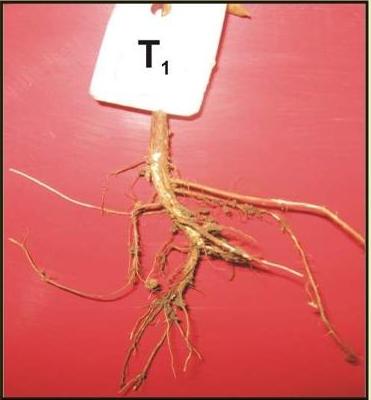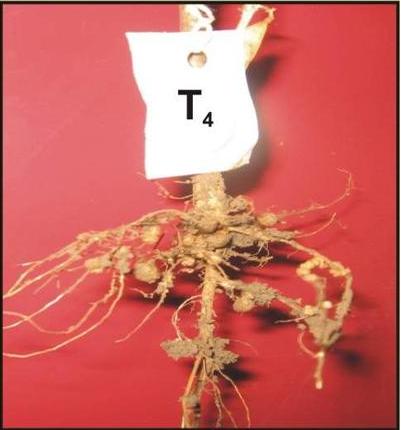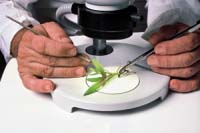Department of Biological Sciences, Gogate Jogalekar College, Ratnagiri.The effect of addition of Agnihotra ash to farm soil was analysed. Four farm soil samples and one soil sample from newly purchased land were selected for the study. Initial microbial count was taken before addition of ash. Ash supplemented soil was analysed after incubation of one week. The microbial count of soil before and after ash addition was enumerated. A marked difference in the count was observed. Addition of ash results in increase in the overall bacterial flora, including the effective bacteria i.e nitrogen fixers and phosphate solubilisers while reduction in the fungal flora was seen.
With regard to soil quality, an improved water holding capacity, an increase in amount and solubility (plant availability) of macro nutrients and trace elements and a stimulation of earth worm activity are postulated as a direct result of Homa treatment [1]. Studies on germination of rice seeds were done for three seasons, autumn, winter and summer. The four parameters i.e. root length, shoot length; fresh weight and dry weight were checked during the studies. The results showed that Agnihotra had a significant effect on the germination process [6]. The potential of Homa farming and Agnihotra ash in particular to improve the solubility and thus the plant availability of soil P was studied by Kratz and Schnug [7].
The effects of Agnihotra and its ash on the environment and plant growth were studied. The effects of Agnihotra fumes on microbial load, SOx and NOx levels in ambient air and plant growth were analysed. Experiments were also conducted to check the effects of Agnihotra ash on seed germination, plant growth, plant genotoxicity and water purification. A decrease in microbial count and SOx levels but slight increase in NOx levels in surrounding air was observed. There was significant increase in seed germination and plant growth as well as genotoxicity was neutralized due to Agnihotra ash [8]. In another study, seeds of Vigna aconitifolia and Vigna unguiculata were taken as experimental material. Agnihotra ash promoted the process of germination [9].
In the present study, the effect of Agnihotra ash on the effective and negative microbial flora of soil was analysed. This study supports the view that Agnihotra ash can be used in increasing the soil fertility.
II. MATERIALS AND METHODS
Collection of soil samples – Farm soil was collected from 4 sites of Shri Chaitanya Mala (Dahagaon, Thane), a Homa organic farm.
i) Soil sample kitchen garden near slurry tank, Survey no. 46/6B
ii) Soil sample of Papaya farm Survey no.46/7
iii) Soil sample of Mango farm Survey no. 46/7
iv) Soil sample of Chikoo farm Survey no. 46/6B
v) Soil sample of newly purchased land Survey no. 46/5A
Preparation of soil suspension – 10 gms of soil sample was weighed and added to 100 ml of sterile distilled water. The flask was shaken well to mix the soil properly. The flask was left standing for 10 minutes. The settled clear suspension was then used for analysis.
Total viable count- Serial dilutions of the soil suspension were prepared using sterile saline. Dilutions were done upto 10 -4 . 0.1ml of the last three dilutions was spread plated on the nutrient agar plates. The plates were incubated and the number of colonies obtained was counted.
Fungal growth – To find the types of fungi present in the soil samples, 0.1 ml of the undiluted soil suspensions were plated on Sabauraud’s agar plates. The plates were incubated and the types of colonies obtained were observed.
Effective or positive bacterial flora – 0.1ml of 10 -4 was plated on Ashby’s medium for nitrogen fixers and on Pikovaskaya’s agar medium for phosphate solubilisers. The plates were incubated at room temperature and number of colonies obtained were counted.
Effect of Agnihotra ash on microbial composition of the soil – The soil samples were treated with Agnihotra ash at 1% concentration and allowed to stand for a week. Soil samples 2 and 4 were mixed together as the amount of soil for microbial and chemical analysis was less. Therefore, this sample is indicated as mixture. The microbial analysis was carried out as described above.
III. RESULTS AND DISCUSSION
The count of the microorganisms in the soil samples and soil samples mixed with ash, was taken by inoculating the soil suspensions on nutrient rich media like Nutrient agar and Sabauraud’s agar media. Normal soil bacteria such as Bacillus sp., Pseudomonas sp., Staphylococcus sp., Micrococcus sp. are usually found in soil.
Two of the effective bacteria were studied i.e nitrogen fixer and phosphate solubilisers. These were isolated on Ashby’s agar and Pikovaskaya’s agar. Nitrogen fixers include the genus Acetobacter sp, Azotobacter sp, etc while the phosphate solubilisers belong to genus Bacillus sp., Pseudomonas sp., etc. The presence of effective bacteria in the soil that help in increasing the soil fertility by their activity were analysed. The groups analysed comprises of nitrogen fixers and phosphate solubilisers.
Table 1. Viable count of flora of soil sample 1 on different media

All bacteria grow on nutrient agar media as it is a rich in nutrients. The total count in the soil (sample 1) was 3.2 x 106 (Table 1). Amongst these bacteria, majority is of the nitrogen fixers as count obtained is 2.0 x 106 , followed by the phosphate solubilisers. Indicates that the soil is very fertile with high count of effective bacteria. In the total bacterial composition, the nitrogen fixers and phosphate solubilising bacteria dominate. The fungi found in the soil are Aspergillus sp., Neurospora sp. and yeast. Normally found in soil and on fruits and vegetables.
In soil sample 2, the count of nitrogen fixers and phosphate solubilisers is very high (Table 2). This indicates that the soil is very fertile with high count of effective bacteria. The fungal types encountered are yeast and Aspergillus sp. These are the normal cultures found in soil. A similar observation was seen in case of soil sample 3 (Table 3)
Table 2. Viable count of flora of soil sample 2 on different media

Table 3. Viable count of flora of soil sample 3 on different media

The analysis of soil sample 4 also showed result similar to soil samples 2 and 3. The count of nitrogen fixers and phosphate solubilisers is very high (Table 4). This indicates that the soil is very fertile with high count of effective bacteria. In the total bacterial composition, the nitrogen fixers and phosphate solubilising bacteria dominate. The fungal types encountered are yeast, Penicillium sp., Rhizopus sp. and Aspergillus sp. These are the normal cultures found in soil and decaying plant material.
Table 4. Viable count of flora of soil sample 4 on different media

In the total bacterial count of control soil, there was incidence of normal soil bacteria. The count of nitrogen fixers and phosphate solubilisers is high. The fungal types encountered are yeast. These are the normal cultures found in soil and decaying plant material.
Table 5. Viable count of flora of soil sample 5 on different media


Fig. 1 Growth of bacterial cells obtained from soil on nutrient agar

Fig. 2 Growth of bacterial cells obtained Fig. 3 Growth of bacterial cells obtained
from soil on Ashby’s agar from soil on Pikovaskaya’s agar

Fig. 4 Growth of fungal cultures obtained from soil on Sabauraud’s agar
Soil was supplemented with ash and incubated for a week. The microbial flora encountered was higher in numbers. The effects of addition of ash are seen very distinctly in the results depicted below.
Table 6. Viable count of flora of Soil sample 1 with ash on different media Media

After addition of 1% Agnihotra ash, an overall increase in the bacterial count is observed from 3.2 x 106 to 5.9 x 107 , in case of soil sample 1. Among these, the nitrogen fixers and the phosphate solubilisers are major contributors and their number is also seen to increase significantly. The count of nitrogen fixer was seen to increase 100 fold while that of phosphate solubilisers was 1000 fold. Thus, after addition of Agnihotra ash, the soil fertility of sample 1, in terms of the nitrogen fixers and phosphate solubilisers is found to increase immensely.
Another significant observation is the inhibition of fungal growth. No growth was observed on the Sabauraud’s media.
Table 7. Viable count of flora of Soil sample 3 with ash on different media

The observations for soil sample 3 after addition of Agnihotra ash were similar to the results obtained in case of soil sample 1, above. The count of phosphate solubilisers is found to increase greatly (Table 7). Growth of fungi is inhibited. Thus, after addition of Agnihotra ash, the soil fertility of sample 3, in terms of the nitrogen fixers and phosphate solubilisers is found to increase.
Table 8. Viable count of flora of Soil mixture with ash on different media

On comparing the results of soil sample 2 and 4 (before ash addition) to the mixture of the two soil samples (2 & 4), to which Agnihotra ash was added, increase in bacterial count is obtained (Table 8). As in the above cases, the count of phosphate solubilisers is seen to increase. Thus, after addition of Agnihotra ash, the soil fertility of mixture, in terms of the nitrogen fixers and phosphate solubilisers is found to increase.
Table 9. Viable count of flora of soil sample 5 with ash on different media

A 100- fold increase in the numbers of nitrogen fixers as well as phosphate solubilisers is observed. It was also observed that the pinpoint yellow coloured culture seen in untreated soil was reduced drastically. Secondly, the growth of fungi is inhibited. Thus, after addition of Agnihotra ash, the soil fertility of sample 5, in terms of the nitrogen fixers and phosphate solubilisers is also found to increase.

Fig. 5. Microbial count of soil sample 1 before and after addition of Agnihotra ash

Fig. 6. Microbial count of soil sample 3 before and after addition of Agnihotra ash

Fig. 7. Microbial count of soil sample 5 before and after addition of Agnihotra ash
Comparing the results of the three soil samples, it can be concluded that:
· Soil samples 1-4 showed good effective microbial composition, prior to addition of Agnihotra ash. This is indicative of good soil fertility, it being an organic farm.
· A further increase in nitrogen fixing, phosphate solubilisers and overall bacterial count, after addition of Agnihotra ash, is seen in all soil samples.
· Addition of ash increases the phosphate solubilisers more than the nitrogen fixers.
· Thus, addition of Agnihotra ash to the soil positively increases the number of effective organisms while suppressing the fungal growth.
In all the sample, the ratio of positive to negative microorganisms is 100:0. i.e the soil contains 100 % positive or effective microorganisms upon treatment with Agnihotra ash.
V. ACKNOWLEDGEMENT
The authors are grateful to the Principal, Gogate Jogalekar College, Ratnagiri (Maharashtra State) for providing all the facilities.
VI. REFERENCES
[1] V .V. Paranjpe, “Homa Therapy – Our Last Chance”. Madison, VA : Fivefold Path, 1989.
[2] B. G. Bhujbal, “Agnihotra and grapes”, Zu finden in [zitiert am 11.07.2007], 1981.
[3] A. Mutalikdesai, “Agricultural experience with vanilla plants” Zu finden in [zitiert am 11.07.2007], 2000.
[4] U. Berk and S. Sharma, “Effect Of Agnihotra Energy Field On Water Purification,” Indian Journal Of Traditional Knowledge, vol. 1, pp. 63, 2015.
[5] D. Atul, J. P. Saini, R. Rameshwar, P. Sood, P. Punam and N. Sharma, “Organic farming in hill agriculture under the plan scheme niche area of excellence – experiment 5: impact of integrated organic crop management on productivity of medicinal plant based system.” Palampur : College of Agriculture, Half yearly Progress Rep, 2006.
[6] J. D. Heisnam, N. V. C. Swamy and H. R. Nagendra, “Effect Of Agnihotra On Germination Of Rice Seeds,” Indian J Traditional Knowledge, vol. 3, pp. 231, 2004.
[7] S. Kratz and E. Schnug, “Homa Farming – A Vedic Fire For Agriculture: Influence Of Agnihotra Ash On Water Solubility Of Soil P”, Landbauforschung Völkenrode, vol. 3, pp. 207, 2007.
[8] P. Abhang, M. Patil and P. Moghe, “Beneficial Effects Of Agnihotra On Environment and Agriculture”, International Journal Of Agricultura
[9] G. R. Pathade and P. Abhang, “Scientific Study Of Vedic Knowledge Agnihotra”, Bharatiya Bouddhik Sampada, 43rd – 44th Issue, 2014.
For correspondence:
Dr. Chanda V. Berde
Department of Biological Sciences,
Gogate Jogalekar College,
Ratnagiri. Maharashtra, India. 415612















 Above Right: Sickly roots on Carnation with Fusarium root rot on from T3 Conventional method
Above Right: Sickly roots on Carnation with Fusarium root rot on from T3 Conventional method
 Above:Remarkably healthy Gerbanas from T2 trial with Organic Agnihotra farming method. Virtually no sign of fusarium wilt on leaves.
Above:Remarkably healthy Gerbanas from T2 trial with Organic Agnihotra farming method. Virtually no sign of fusarium wilt on leaves.

 Above left to right: Alternaria leaf spot on T3 Conventional cabbage plants; downy mildew on T3 cabbage plant
Above left to right: Alternaria leaf spot on T3 Conventional cabbage plants; downy mildew on T3 cabbage plant Above: Healthy cabbage T3 Organic Agnihotra plant from the study, with no signs of leaf spot or mildew
Above: Healthy cabbage T3 Organic Agnihotra plant from the study, with no signs of leaf spot or mildew

